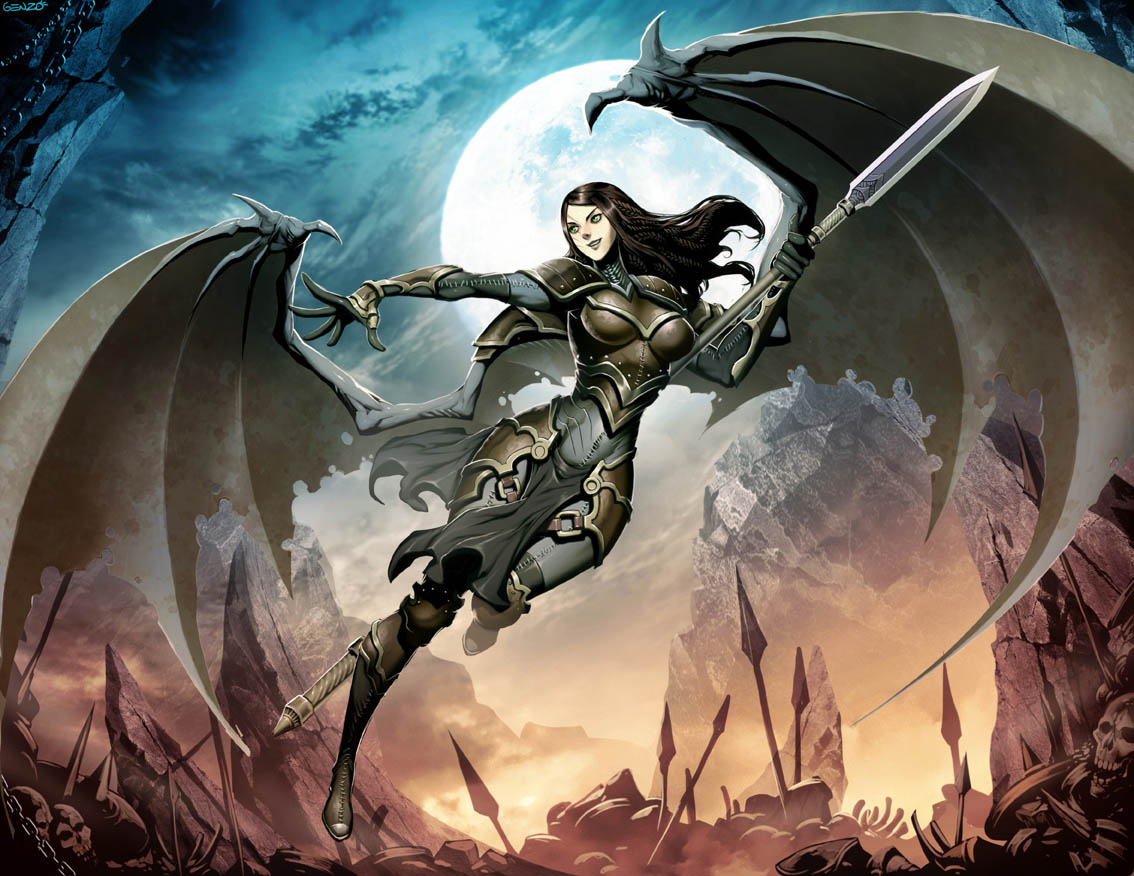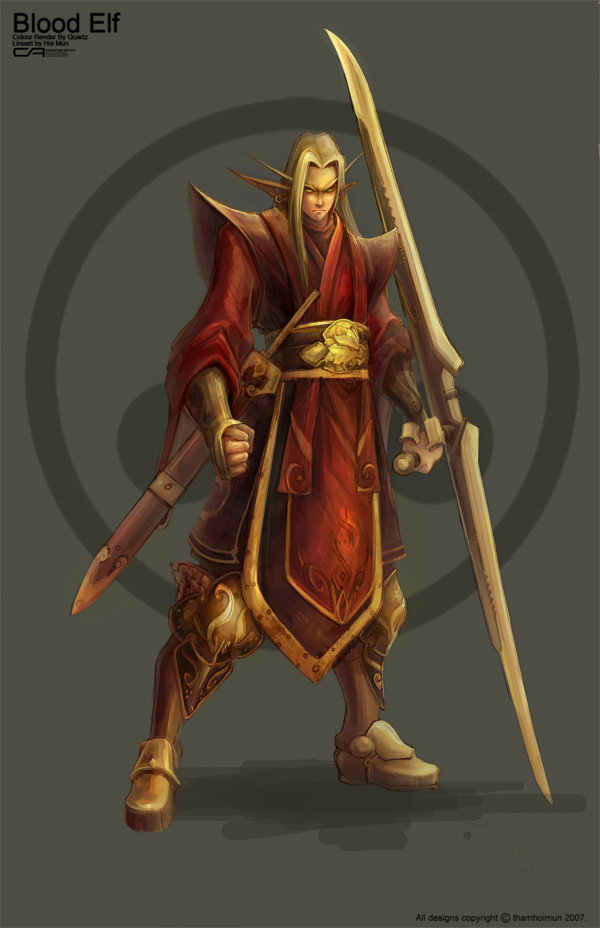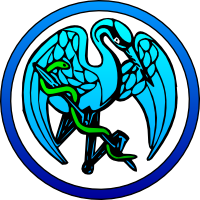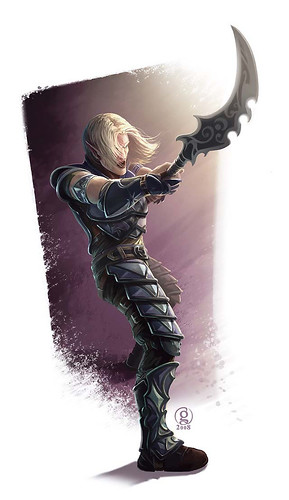Ah, now onto part 2. I really wanted to go for the gusto with this build up of the Fey'ri. So, I've got the stats done, now it's time for the Favored Class Options and maybe some Racial Traits.
Fey'ri Adventurers
It is a rare fey'ri that doesn't have some training in an adventuring class. Most fey'ri have spent at least a little time as one type of rogue or another. Quite a few fey'ri also favor the arcane arts of all broad strokes. It's rare, though, to find a divinely leaning fey'ri, causing clerics and paladins among the "tainted blooded" to be an unusual find.
Alchemist - It was the desire to gain the strength to defeat all who opposed them that caused the fey'ri to branch off from the elves to begin with. It's no surprise, then, that more than a few fey'ri have started to dabble in alchemy. Mutagens are a favorite, while the odd satisfaction of a foe's reaction as the lovingly distilled poison begins its work is not lost on a fey'ri alchemist.
Barbarian - Fey'ri rarely give in overtly to the fires that burn in their mottled blood. While a fey'ri may make use of barbarians as thugs and shock troops, it's not a role that they, themselves, favor. A fey'ri barbarian, especially one with an urban focus, is possible, but they are often looked upon with either shame or pity by the houses.
Bard - Much like their elven cousins and ancestors, fey'ri love performance in all it's varied forms. Fey'ri bards pass themselves off as elven bards as often as they can, and it is rumored that a few masterworks attributed to the elves are actually the works of a fey'ri incognito. Fey'ri bards frequently travel the width and breath of the world, not only exploring, entertaining and adventuring, but also serving to keep the lines of communication open between houses.
 Cavalier -
Cavalier - The role of a noble knight is not one lost among the fey'ri. It's uncommon, because it requires a bit more of a martial lean than what more fey'ri tend to have, but it's a role respected by the houses. Also, the prestige that a military officer can benefit a smart fey'ri in any number of ways. Fey'ri cavaliers will commonly command smaller, elite groups and strike forces, as opposed to heading massive armies.
Cleric - While most fey'ri will present a fair amount of lip service to any number of gods and god-like beings, it is truly the unique fey'ri that would willing serve one. It may be the infernal taint on the soul of the fey'ri, or it may just be a deep seated racial hubris, but to become a cleric is a role that most fey'ri would rather pass on and leave to others.
Druid - It is said that the fey'ri are no longer tied to the natural world as they once were. This is, for the most part, true. The lack of desire to bind oneself to a "god" does occasionally bleed into the attitude towards druids, but not as much as one might think at first glance. Being tied to the "world" or "the spirits" implies to a fey'ri that they are working with equals, rather than subservient to a "higher force". A few urban druids serve the houses, as do a number of shamans of differing bent, depending on the location.
Fighter - While not as devoted to swordsmanship as their elven cousins, the fey'ri understand the beauty and need for a good blade. Fey'ri fighters prefer using elegant blades, or mastering the skills of archery, and their devotion to the warrior arts are greatly respected among the houses.
Gunslinger - Rare is the wielder of the gun among the fey'ri. Too new to have really taken root, too loud to be used subtly, and too expensive for the tastes of many fey'ri, there are very few fey'ri that are willing to pick up firearms. Those that have picked up the skills of a gunslinger are beginning to stir up quite a bit of curiosity among the houses.
Inquisitor - Possibly the only class less favored than clerics, fey'ri inquisitors are all but unheard of. Rare is the inquisitor willing to take a tainted soul such as a fey'ri under her tutelage. Rarer still is the fey'ri that would even get a chance to ask. Normally, inquisitors hunt beings like the fey'ri and they less the houses have dealings with them, the better. The few fey'ri that take up an inquisition normally server the houses and the fey'ri first and foremost and are some the house masters greatest enforcers.
Magus - Mastery of both weapon and magic, fey'ri hold close to the traditions of the magus as handed down to them from before the elves left. Most bodyguards and wandering warriors among the houses are trained as magi, and more than a few fey'ri walk among adventures and city defenders, a pinnacle of "elven training and tradition".
Monk - Not a race prone to a lot of introspection, monks are not common among the fey'ri. There are some that do find value in the search of personal perfection and enlightenment. A fey'ri monk tends towards some of the more mobile, mystically inclined, and unorthodox disciplines.
Ninja - There are no ninja among the fey'ri. Now, if you would be so kind as to tell me who it was that suggested that there might be, I would very much like to have a word with them.
Oracle - Surprisingly, oracles are actually more common among the fey'ri than clerics. Oracles among the fey'ri tend to follow mysteries that involve secrets, deception, and divination.
Paladin - There are no paladins among the fey'ri. No, seriously. If a young, idealistic fey'ri was to suddenly get it in his or her head to become a paladin, they would end up spending quite a few days having their head examined. Then they would either be directed to magus training or sent "away".
Ranger - Rangers often serve much the same role as bards, serving to keep communication flowing and exploring new locations and old ruins. While the lone rugged life of a ranger is not one that every fey'ri is accustomed to, the potential rewards can not be downplayed. A fey'ri ranger though will often favor stealth and subterfuge, instead of more open confrontations.
 Rogue -
Rogue - Possibly the most common class among the fey'ri, even most spell casters have dappled a bit as a rogue as they grew up. The urban homes of the fey'ri and the need to hide and disguise their actions, thoughts, and motives greatly benefit for some time learning at the foot of a good cutpurse, acrobat, or similar type character.
Samurai - In lands where the tradition of samurai serve as a noble class of warriors and defenders, you will find the occasional fey'ri behind a mempo. Though some would say that the traditions of honor and duty fly in the face of the fey'ri, it would only be because one does not truly understand the fey'ri. Those same would not say such things for long, were they to suggest such openly.
Sorcerer - Another very common class, more due to the origins of the race, sorcerers of all stripes are welcomed and embraced. The only exceptions are ones with celestial, verdant, or other "high blooded" bloodlines, and even these more cause a raise of an eyebrow than any real shunning. Much like rogues, more than a few fey'ri of other classes may have a level or two of sorcerer, more because the magic is just that powerful in the blood.
Summoner - A tradition that has been with the fey'ri from the very beginning, summoners are a revered and respected group. Fey'ri summoners often have a wide variety of eidolons, some appearing as amalgamated beings thrown together from a number of different sources, while some have "idealized" forms of outsiders. Fey'ri summoners pride themselves on getting the most out of their eidolons.
Witch - Fey'ri witches find themselves in an very difficult position in fey'ri society. On one hand they feared and respected for their flexible and powerful abilities, on the other, being tied to some mysterious "patron" does make more than a few fey'ri nervous. Some fey'ri witches will go out of their way to determine the source of their magic even before making the pact, others assume that if it's something powerful enough to grant them their abilities it may be better that they just don't look into it. Fey'ri witches tend to favor "flashy" or overtly powerful patrons, some what stepping out of the norm for fey'ri culture.
Wizard - Another strong tradition among the fey'ri, wizards serve many rolls among the houses. Most wizards specialize in illusion, enchantment, or conjuration. Necromancers do occasionally rise from the ranks, but a fey'ri approaches this more with a practical, scholarly mindset, most of the time. It is also common to find elemental wizards frequently among the houses. Occasionally houses from neighboring lands will attempt to "collect" wizards from every school and tradition available to them as a sign of prestige, not an easy feat considering the small number of the race.
Favored Class Alternatives
Instead of receiving an additional skill rank or hit point whenever they gain a level in a Favored Class, fey'ri have the option of choosing from a number of other bonuses, depending upon their Favored Classes. The following options are available to all fey'ri who have the listed Favored Class, and unless otherwise stated, the bonus applies each time you select the listed Favored Class reward.
Alchemist - Add 1 minute to the duration of any mutagen the fey'ri alchemist takes.
Bard - Add 1 to the fey'ri’s total number of bardic performance rounds per day.
Magus - Add +1/4 to the Magus' arcane pool.
Ninja - Add +1/4 to the Ninja's ki pool.
(That's if there really were ninja, which there aren't. I'm just saying.)
Rogue - The fey'ri gains +1/6 of a new rogue talent.
Sorcerer - Select one bloodline power at 1st level that is normally usable a number of times per day equal to 3 + the sorcerer’s Charisma modifier. The sorcerer adds +1/2 to the number of uses per day of that bloodline power.
Summoner - Add +1/4 to the eidolon’s evolution pool.
Wizard - Select one arcane school power at 1st level that is normally usable a number of times per day equal to 3 + the wizard’s Intelligence modifier. The wizard adds +1/2 to the number of uses per day of that arcane school power.
 First and foremost, the writers get to be Laaazy. There's no need to come up with something new. It's all written, illustrated; characters have been created and fleshed out. Just grab the Thrawn Trilogy and go. There's material from 30 minutes after the Death Star blowing up to almost a century later! Timeline is all laid out and the continuity is pretty much set in stone. Harrison Ford, Mark Hamill and Carrie Fisher would be in work until they died.
First and foremost, the writers get to be Laaazy. There's no need to come up with something new. It's all written, illustrated; characters have been created and fleshed out. Just grab the Thrawn Trilogy and go. There's material from 30 minutes after the Death Star blowing up to almost a century later! Timeline is all laid out and the continuity is pretty much set in stone. Harrison Ford, Mark Hamill and Carrie Fisher would be in work until they died.



























